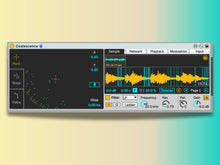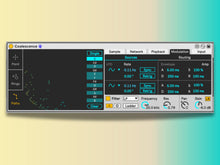Coalescence by Dillon Bastan
Coalescence is a Max for Live Instrument that combines concatenative sampling together with a neural network. Coalescence takes multiple samples (up to 2000), analyzes them and feeds slices of the samples into the neural network (an SOM) which organizes the samples into a 2D map of cells, which you can see visualized as little circles.
The device plays around with this organization of sound slices using three different playback modes: Point, Rings, and Paths.
Comes with:
The device, user manual, 42 presets, 14 samples, Strange Mod modulator device (for one of the presets).
Version Info:
Works with Live 10 and up!
Features
-
Supports dropping of multiple samples, individual or folders (up to 2000), for concatenative sampling. Each sample has individual parameters for pitch, volume, direction and transient sensitivity.
-
Neural Network (SOM) that organizes sample slices based on a chosen spectral feature and visualizes them in a 2D circle.
Three playback modes
-
Point: choose a single sample slice point to play from, MIDI repitches playback. Closest to a classic sampler. Option for external audio input to control lookup point based on similarity.
- Rings: MIDI pitches trigger circlular ranges called Rings, when a Ring is triggered it plays a random sample within its range. Great for drum kits, or any kind of sample slicing. There are auto and manual Ring creation options.
-
Paths: MIDI pitches trigger individual playback paths that can glide or jump through the sample slices. Great for creating sequences or all kinds of movement! Alternatively there is a Single path mode in which only one path can be triggered and MIDI pitches instead repitch the playback.
Various settings for the network including ones for training and previewing the network:
-
4 different spectral features to choose for clustering the sample slices: (Chroma) describes the slice in terms of a 24 step chromatic scale, good for sorting based on tonality. (Mel and Bark) these two describe the slice with intensities from low to high frequencies based on psychoacoustic perceptions of equal distant steps. Each scales the frequencies differently, good for anything you want sorted based on low to high frequencies such as percussion, etc. (Speech) uses Mel Cepstral Coefficients (MFCC) which are commonly used for speech recognition, good for sorting vowels, etc.
- Option to use transients only for the sample slices fed into the network or using every spectral frame
- Cluster radius size and various training parameters
Various sample playback settings:
- Standard playback settings such as voices, playback direction, one shot or loop, loop size (can be in time, beats, or by transient length), pitch, and fade window
- Various parameters for the different playback modes and sample slice lookup
- A phase vocoder playback mode where you can time stretch. It also has a spectral attack and release for cheap blur effects or fading between specra
External audio input routing with various uses:
- Option to have the sampler voices triggered by the input transient detector instead of by MIDI notes. This way you can trigger voices of the sampler with an external input!
- As mentioned the input can optionally control what sample slice is playing based on its similarity to the input at any moment. This opens up the doors for a pseudo style-transfer and other effects (Note: they are not the cleanest and most robust results but great for experimentation and can work well if dialed-in and handled correctly). Some examples of uses: beat boxing with voice to trigger drum sounds, having one sound 'mask' another such as style-transfer-esk effect (using the phase vocoder playback mode), creating a voice controlled synth, etc
- An envelope follower and pitch detector which can be used for modulation.
A modulation system, each modulation source has two mappable destinations:
- Two LFO's with perlin noise options
- Two envelopes
- Two random spray values created at the beginning of each voice
- The routed external audio input's envelope follower and pitch detector
- Standard MIDI sources: velocity, key pitch, aftertouch, pitch bend, mod wheel
Per voice filter with a few modes:
- Standard simple biquad filter with standard shapes
- Ladder filter mode
- Vowel or Formant filter mode with formant options, frequecy shifting, spreading, and bandwidth sloping
What Is Max for Live?
Max For Live is a powerful platform that allows producers to create custom instruments and audio effects from a vast library of tools. It boasts intuitive workflow and performance capabilities, allowing producers to quickly create and share their work. With Max For Live, producers can take their creativity to the next level.






